















REVIEW OF ROAD RACING SEASON |
|---|

|
The New York Times
January 8, 1911
Eighteen Drivers Divide 21 Contests-Mulford Tetzlaff and Zengel Share Honors.
During the road racing season of 1910 no lass than 106 different drivers took part in twenty-one contests, and of these only eighteen were winners. This roll of honor includes Mulford, Tetzlaff and Zengel, with two each, and Dawson, Aitken, Bruce-Brown, Dave Buck, Bill Endicott, Grant, Fancher, Geinaw, Gellard, Herrick, Hearne, Knipper, Livingstone, McKeague, and Pdula, with one each. Besides Chevrolet, de Palma, Hanshue, and Robertson, the list of also-rans includes Fleming, Harroun, Nazzaro, Oldfield and Wagner, men you usually look upon as winners when they come to the tape.
Mulford did not win his title as champion driver of the year without competition. Indeed it was possible that Joe Dawson ought to be given a higher ranking than the one with which he is credited. Dawson's work was gilt-edged throughout the season, and had he been in a bigger car, Mulford would have had to look to his laurels. In most of the events in which Dawson participated he was forced to go out of his class, and yet he managed to run second to Grant in the Vanderbilt in his little Marmon, beaten only by a matter of 25 seconds. The difference between Mulford and Dawson is best explained by the fact that where Mulford in most cases was able to run well within the powers of his car, Dawson had to open his throttle to its limit and travel all out in order to hold his own in the fast company in which he was traveling. The Indianapolis lad, who was one of the speedway stars of the season, undoubtedly is one of the greatest of American drivers and one whose work should be closely watched in the future.
Tetzlaff, who is entitled to a high ranking, is an unknown quantity. While he won two races in California in record time, still it must be admitted that the competition he had on the Pacific Coast was not of the class against which Dawson and Mulford competed. Outside of Bert Dingley there wasn't a driver at Los Angeles who ever before had been heard of in other sections of the country. While due credit should be given Tetzlaff for his grand work, it is the opinion of the critics that he hardly is entitled to very high ranking among the other drivers as yet. David Bruce-Brown, winner of the Grand Prix, is a youngster of great promise. He drove only twice in 1910, but his work at Savannah, when he followed out a carefully planned schedule, shows that he is to be reckoned with hereafter.
Harry Grant should well be satisfied with his one victory, for the Vanderbilt win represents the ambition of Grant's life-to capture the American classic twice, and to do it twice in succession and in the same car. Therefore Grant probably does not feel at all humiliated because of his defeat at Elgin and Savannah, where on both occasions he met with mishaps which put him out of the running early in the fray.
Taking the drivers who achieved fame in the small-car races, the past season developed Bill Endicott and Eddie Hearne as pilots of ability. Bill Knipper already had won his spurs, and therefore it is not surprising that he should have won the Tiedeman Cup as easily as he did. Undoubtedly he would have added to his laurels and would have won the Massapequa Cup at the Vanderbilt meet had it not been for an accident which occurred when he had the race well in hand.
Al Livingstone should not be forgotten in reviewing the work of the pilots of 1910, for the death of this rising star at Atlanta undoubtedly robbed the racing world of a driver who was rapidly climbing to the top. Indeed, it is a question if Livingstone should not be ranked third to Mulford and Dawson for the season. He won the Illinois Cup at Elgin, and performed brilliantly the following day, when he was second to Mulford in the Lozier in the Elgin National race itself. He had hard luck in the Vanderbilt, and planned to go to California and participated in the Santa Monica events, where undoubtedly he would have been a big factor becuase of his skill and daring. Also, he probably would have driven at Savannah, where he would have had another chance to add to his fame.
Racing in 1910 resulted in the death of more celebrities than in the previous season. Livingstone was not the only one to pay the penalty for his daring, for the mortuary list also contains the names of several other well-known drivers. Tobin De Hymel, a lad of great promise, met death in a track race at San Antonio after he had shown he was in line for great honors in the driving world. De Hymel had driven in the Vanderbilt and in the Fairmont Park races. In the latter he had performed most consistently, getting third place, and great things were expected of him in the future. Another to cross the great divide was W. H. Sharp, manufacturer of the Sharp-Arrow, who died as a result of injuries sustained in training for the Grand Prix at Savannah. Tom Kincade of the National team met death on the Indianapolis Speedway.
